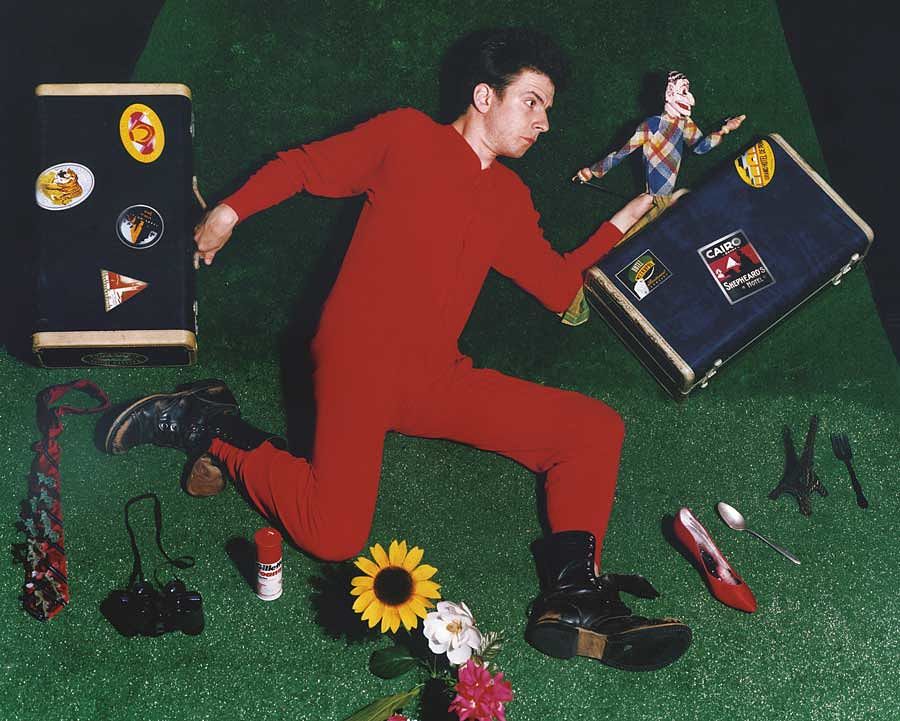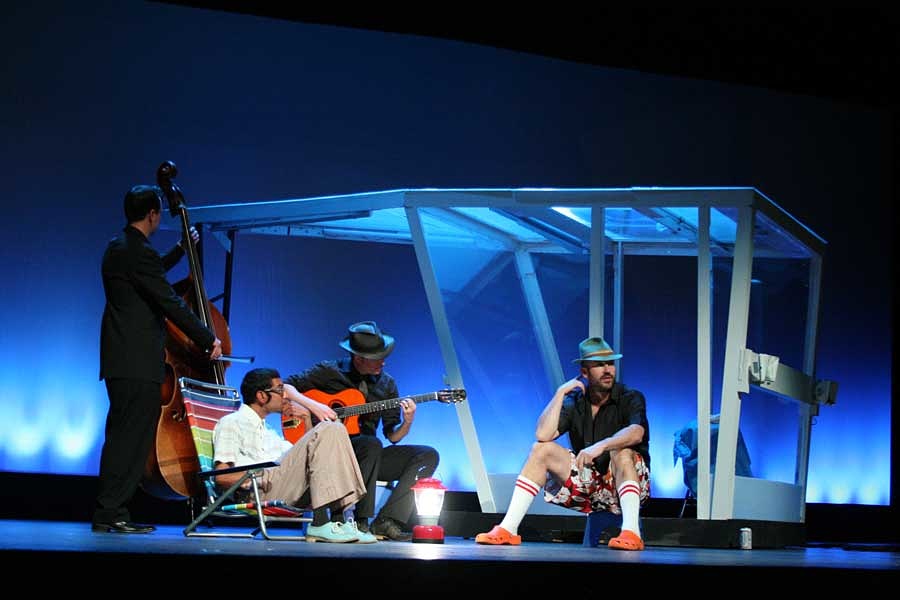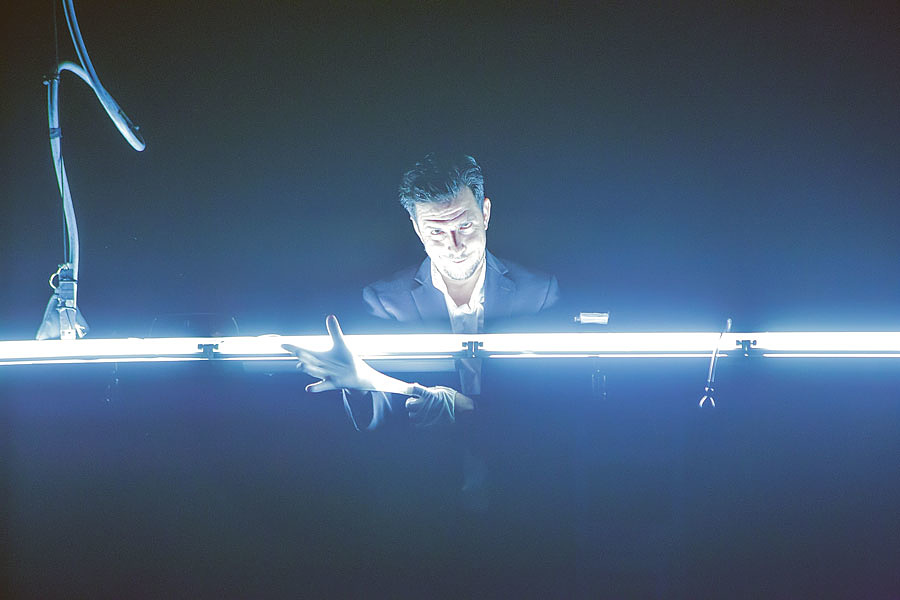Critics have likened him to Charlie Chaplin and to Spalding Gray. Really? A very physical silent comedian and a raconteur who sat behind a table? Also to Robert Lepage, whose visually stunning stagings hardly resemble either Chaplin or Gray’s worlds. Meanwhile, the artist himself says a key influence has been Drak Puppet Theatre in the Czech Republic.
Thaddeus Phillips, whose 17 Border Crossings plays Feb. 2–6 at the Blue Room Theatre in Perth, Australia, obviously must be some kind of shape-shifter. Or, at least, his theatre must change wildly from piece to piece. In a way, both are true. He staged a solo version of Shakespeare’s The Tempest (1996) in a plastic kiddie wading pool, with white sheets transforming from sails to billowing storm clouds to shadow screens to a stage curtain. In ¡El Conquistador! (2010), an original play, he portrayed a doorman, silent except for intercom interactions with building residents, who appeared on a video screen; as the doorman walked around the lobby, the projected scenery shifted in sync with him, frequently changing the audience’s viewing angle. Phillips’s new Alias Ellis Mackenzie (2015) shows the filming of a TV serial melodrama about a drug-cartel pilot; it uses a dozen actors on a huge stage filled with painted flats, real Cadillac parts, and skeletal versions of camera boom arms.
For all its variety, though, Phillips’s work has a consistent core. A key element is almost always his presence on the stage—protean, often funny, and somehow the audience’s ally. He typically offers a wry and compassionate, if sometimes barbed, take on contemporary issues. And his stagings, which incorporate music, continually transform and repurpose basic objects in what he describes as “liquid stage space.”
Phillips’s focus on the physical landscape of the stage goes back, he says, to his high school years, when he was performing in musicals such as South Pacific and How to Succeed in Business Without Really Trying. During his theatre studies at Colorado College, a couple of British directors who had been strongly influenced by Peter Brook heightened his fascination with “the possibilities of physical space.” Another major influence in college was Encho Avramov, a no-nonsense taskmaster originally from Bulgaria, who had studied at Charles University (DAMU) in Prague, a center for alternative and puppet theatre.

And, importantly, while in college Phillips discovered the work of Robert Lepage: During a semester in Chicago in 1990, he saw Dragon’s Trilogy. He loved not only Lepage’s use of space but also his way of placing everyday elements into a heightened environment. He would “have a thing that is hyper-realistic, like calling a receptionist on the phone,” Phillips recalls, “and then turn it on its head with just a little bit of poetry, something that transforms it.”
For Phillips, the inspiration from Lepage was pivotal. After college, Phillips got an “observership” with the director. Later, in 1999, he performed in Lepage’s The Geometry of Miracles.
Meanwhile, in 1994, Phillips had seen one of the legendary Henson puppetry festivals in New York. Excited by the creativity and skill he saw in the work of such artists as Basil Twist, Roman Paska, and Fred Curchack, he determined to do more with puppetry. He arranged, then, to spend a year at Charles University (DAMU) in Prague, and while there he interned with Josef Krofta at the Drak Puppet Theatre.
Krofta’s creative process fed Phillips’s developing aesthetic. Drak, he recalls, conceived and built a basic set early on and then rehearsed on it. “The set,” Phillips says, “helped to write the show.” The configuration of the space and objects on the stage could suggest characters’ actions. For example, because two sticks anchored the rotating set of Drak’s Don Quixote, Krofta said those poles needed some purpose in the story. They became skis for the puppets.
After his year in Prague, Phillips jumped into the Philadelphia theatre scene, acting in a local Equity company and creating original shows. He founded Lucidity Suitcase Intercontinental as a formal home for his theatre, and his work soon became a regular highlight of the Philadelphia Fringe Festival.
Lucidity’s first project was a one-man version of King Lear, reimagining it as “simple object theatre.” Cutting but not otherwise altering the text, Phillips ran with the idea that “Lear is a tyrant—and he’s retiring.” So, where do retired big shots hang out? “We set it on an Astroturf miniature golf course.” Phillips played Lear and spoke for all the characters, such as they were. For the king’s daughters, he animated a red shoe, a scarf, and a live daisy. The fool was a Javanese rod puppet that hid in Lear’s golf bag. To play Kent, Phillips put on black-rimmed glasses (Clark Kent?).
Lear caught the attention of local critics. Philadelphia City Paper called Phillips’s crazy Lear “as meaningful, and occasionally as moving, as many traditional productions I’ve seen.” Another local review called it “a show of prodigious energy, copious magic, and Southern gothic melodrama.”
The following year Phillips created his Tempest in a kiddie pool. This time, Phillips/Prospero’s image in a hand mirror embodied Ariel, the magician’s semi-corporeal reflection. Prospero’s silhouette on the sheet played his monstrous shadow, Caliban. And an empty shirt portrayed the usurper Antonio and his courtiers. Again, the show garnered critical praise. Over the next couple of years, he performed the two shows together as Shakespeare’s Storms in Philadelphia and in separate runs at La MaMa in New York City.
Phillips did not make another one-man Shakespeare until 2003. In the wake of the U.S. invasion of Iraq and Afghanistan, he created Henry V, Live From Times Square, with characters played by toy soldiers and a Perrier bottle (the French king, of course). “Shock and awe” war footage backed the action, and King Henry’s unintelligible diagram to explicate the battlefield situation echoed Colin Powell’s infamous U.N. presentation.
Between his Shakespeares, Phillips had begun turning out original works inspired by his own life. An example was Lost Soles (2001), in which a tap dancer gets stranded in Cuba at the time of the revolution. The dancer’s training and (some of his) Cuban experiences were Phillips’s own. As the grandson of a successful vaudeville tap dancer, Phillips had learned tap as a child and continued his training as an adult, seeking out master teachers. And, like his fictional alter ego, he had traveled to Cuba partly because one of his mentors was from the island.
Lost Soles showcased Phillips’s dancing on a soda fountain–sized platform shaped like a U, with the audience watching at foot level. Donning and doffing hats, sunglasses, and shoes, accompanied by video of Cuba, he played all the eccentric teachers and Cuban border agents as well as the protagonist. Phillips performed Lost Soles in Philadelphia, Denver, and New York.

Expanding beyond solo plays, for the past 15 years Phillips has collaborated with the Colombian director Tatiana Mallarino (now his wife) and various musicians to develop both one-man and larger-cast works. Flamingo/Winnebago (2007), for example, is a musical road trip comedy featuring four actors and an onstage band. In the show, an Indian immigrant abandons his business, a Sinclair gas station (complete with dinosaur logo), and heads for California in a Winnebago. He picks up a hitchhiker, played by Phillips, en route to the Flamingo Hotel in Las Vegas (where Phillips’s grandfather once worked). Along the way, their conversations—with each other, the OnStar operator, and the people they meet—present a zany collage of Americana, while also focusing on the inevitable extinction (like dinosaurs) of a species dependent on fossil fuel.
Phillips credits Lepage with inspiring his Flamingo/Winnebago set, which rotates to create a dozen-plus locales. The design consists of an eight-foot skeletal box with a triangular awning on one side. Getting minimal additions—headlights, a shelf—and projections, it becomes the Sinclair station, the Winnebago, a diner, a room at the Flamingo, and other places.
Red-Eye to Havre de Grace (2012), which is one of Phillips’s best-known pieces and will appear in April at New Hampshire’s Hopkins Center for the Arts and at the Georgia Institute of Technology, has also played in Philadelphia, New York, Minneapolis, and Boston. Based on the final days of Edgar Allan Poe, it is one of the few Lucidity Suitcase pieces in which Phillips does not perform and that is not directly inspired by events in his life. As director and designer, Phillips created the work with the Wilhelm Bros. & Co., musicians who also perform in the piece. Actor Ean Sheehy, who bears an eerie resemblance to Poe, plays the lead. Employing Phillips’s usual “liquid staging,” the piece climaxes with a stunning spotlighted image of Poe lying splayed across an open grand piano as if crucified or buried, while “doctors” hovering over him bow the piano strings.
An oddball inspiration for several recent pieces has been his work in Colombian television. He and Mallarino divide their time between Bogotá and Philadelphia, and in Colombia, Phillips played an airplane pilot in a popular TV serial about the drug cartels. Telenovela serials in turn inspired ¡El Conquistador!, with its sad-sack doorman who is besotted with TV soaps—until his life turns into one. His misadventures include unwelcome love interests, a long-lost identical twin, a Mafia hit, and a return from the (not really) dead. To jack up the fun, all the “tenants” on the intercom video were actual telenovela superstars from Bogotá, Phillips’s and Mallarino’s relatives and friends.
Phillips’s TV role as the pilot also sparked two plays about the actual person, Barry Seal (alias Ellis Mackenzie), on whom his character was based. A crack pilot and thrill-seeker, Seal worked simultaneously for the drug cartels and the U.S. Drug Enforcement Agency, organizing a sting on Pablo Escobar. Finding Seal as fascinating as the cartel principals, in 2015 Phillips created both Alias Ellis Mackenzie and a prequel, The Incredibly Dangerous Astonishing Lucrative and Potentially TRUE Adventures of Barry Seal.
By now, Phillips’s work has been seen all around the U.S. (Washington, D.C., Denver, Cleveland, Miami, etc.—as well as Philadelphia and New York). He has performed in theatre festivals in Europe and South America. This month, Phillips is appearing at a “Summer Nights” festival in Perth, Western Australia.
The play in Perth, 17 Border Crossings, also occasioned Phillips’s debut last fall at Brooklyn Academy of Music’s Next Wave Festival. A solo work based on his own travels, the piece not only reflects many of Phillips’s key influences, but also showcases the way he transmutes them into his own brand of theatre.
He starts the play talking to the audience while seated at a small table. But soon he radically repurposes his table and chair, plus a standing microphone and a 15-foot-long adjustable horizontal light bar, to create train carriages, airplane interiors, an Austrian ski lift, a sleazy Croatian bar, a beach, a motorcycle, and lots of customs counters. For one scene, in Bali, he rotates the furniture and himself onto their sides, giving the audience an “overhead” view—a trick that Lepage also has used.
In 17 Border Crossings, as in his previous solo shows, Phillips narrates the action and plays a bevy of characters, in this case slipping into half a dozen languages. A slouchy stride and a shirt-end sticking through his open fly turn him into the Hungarian border agent on a train; a different swagger creates a brazen smuggler on the same journey. Some of Phillips’s transformations are incredibly subtle. At the Havana airport, in a tight window (made by the lowered light bar and the chair seat) he plays both himself and the border agent. The audience sees only Phillips’s face. He switches character purely through internal changes that we detect in his eyes—uncertainty versus genial confidence. We always know which character is speaking.
In fact, Phillips is a remarkable actor. His goal, he says, includes embodying human interactions “in a realistic, Sandy Meisner kind of way.” But placing those believable actions in his “liquid stage space” changes everything and makes his theatre very different from workaday realism. It is, he says, “kind of a third way,” very much inspired by the work of both Lepage and Peter Brook.
So what about the comparisons to Chaplin and Gray? It is mainly the straight narration parts of 17 Border Crossings that have triggered references to Spalding Gray. Indeed, Phillips himself says that the show is his only one in which he senses much echo of Gray. But there is a deeper connection. Though Phillips’s subtly antic relationship with the audience is very much his own, his narration style—a kind of intimate, often droll presentation—very much recalls Gray’s. This is true even when Phillips moves about the stage while telling his stories—as in Capsule 33 (a solo piece about a Japanese “capsule” apartment and Nikola Tesla, among other things), in which he walks around and draws on a map while recounting the story of 28,000 shipwrecked rubber ducks.
And Chaplin? He is deeply flattered by the comparison, of course, but he demurs at first, saying, “Maybe it’s because I’m goofy.” On further thought, he talks of sharing with Chaplin a “total devotion to and seriousness about the act of playing, like a child,” in order to create stage magic. He adds that in a certain way, his grandmother’s vaudeville style “was handed down to my mom, who passed it on to me.” He also thinks he shares with Chaplin “a very deep conviction of speaking up for the underdog and the downtrodden that also runs in the veins of my theatre creations.”
For the future, Phillips would like to revive a few of his works, particularly Flamingo/Winnebago. But he is most interested now in branching out and directing other playwrights’ work, lest he get “trapped in my own ideas.” He wants “to expose and explore new aspects of existing plays and stretch my own creativity.” Put simply, he says, “I’m a director out for hire looking for work.”
Eileen Blumenthal, a critic and scholar based in New York City, is a professor of theatre at Mason Gross School of the Arts at Rutgers University.


